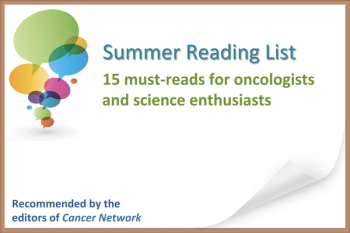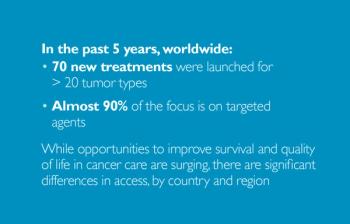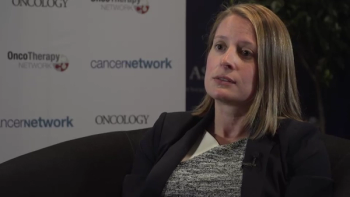
In this Medical News Minute, developed exclusively for Cancer Network, Dr. Bobby Lazzara discusses a recent study that compared EndoPredict and Oncotype DX, which both predict the likelihood of a breast cancer recurrence.

Your AI-Trained Oncology Knowledge Connection!


In this Medical News Minute, developed exclusively for Cancer Network, Dr. Bobby Lazzara discusses a recent study that compared EndoPredict and Oncotype DX, which both predict the likelihood of a breast cancer recurrence.

This article will address changes in CINV guidelines over the past 5 years and provide updates on recently approved agents and agents that are expected to be approved, based on published phase III trials. It will also explore other factors affecting optimal CINV control, including the role of patient-related risk factors and the role of physician adherence to antiemetic guidelines in reducing the residual risk of CINV.

Beyond the current recommendations for management of chemotherapy-induced nausea and vomiting, recent research has shown significant improvement in emesis control with use of triplet therapy using dexamethasone, an NK1 receptor antagonist, and a 5-HT3 receptor antagonist in patients undergoing non–anthracycline-plus-cyclophosphamide-based moderately emetogenic chemotherapy.

Bone metastases are common in advanced breast cancer, and may be associated with serious morbidity, including fractures, pain, nerve compression, and hypercalcemia. Through optimum multidisciplinary management and the use of bone-targeted treatments, patients with advanced breast cancer have experienced a major reduction in skeletal complications, less bone pain, and an improved quality of life.

It is quite obvious that bone morbidity has a negative impact on our patients with breast cancer. The use of bone-modifying agents in this setting can yield significant quality-of-life benefits.

In this interview we discuss PSA screening for prostate cancer, the compromised results of the PLCO trial, and more.

The relationship between oncologists and their patients is labor-intensive and arouses great emotions. The specter of death is always in the shadows; as it waits patiently, it makes conversations poignant. Oncologists should be skilled in soothing the fears of their patients without appearing trite or patronizing.

We present a summer reading list of 15 must-reads that cover the history of genes and cancer, the link between so-called junk DNA and disease, uncertainty in medicine, and more.

An infrared laser-based version of the traditional Chinese medicinal technique known as moxibustion was found to improve cancer-related fatigue.

Patients with glioblastoma who were uninsured or who had Medicaid at the time of diagnosis were more likely to be diagnosed with a larger tumor and had shorter survival times.

Read compelling analyses of 5-year trends and projected changes in the oncology clinical drug pipeline, selected from the IMS Institute for Healthcare Informatics’ recent “Global Oncology Trend Report.”

Are you up to date on the latest BRAF and MEK inhibitors used in melanoma? How about the most common location of metastasis in uveal melanoma? Answer these questions and more.

Ten percent of advanced cancer patients have developed delirium, but it is often missed by emergency department physicians.

Patients continue to say they want more information, so they can make informed decisions. But repeatedly, studies tell us that the patient and the family are not hearing us, not understanding us, or both.

A recent study found that radiologists differ in their interpretation of whether a woman has dense breasts based on mammography.

Acupressure, a technique derived from acupuncture, helped improve sleep and relieved chronic fatigue experienced by women treated for breast cancer.

Adding the antipsychotic drug olanzapine to a standard antiemetic regimen significantly improved prevention of nausea caused by emetogenic chemotherapy.

A new study has found an increased risk for a cancer diagnosis during the 10 years prior to and the 3 months immediately after being diagnosed with type 2 diabetes.

In this Medical News Minute, developed exclusively for Cancer Network, Dr. Bobby Lazzara discusses a study that looked at the link between air pollution and the risk of various cancers.

Can you name all of the approved melanoma agents that modulate the immune system? How about the targets and side effects associated with these treatments? Answer these questions and more.

In this video we discuss the use of concurrent immunotherapy and stereotactic radiosurgery for treatment of melanoma brain metastases.

Undergoing immunotherapy within a month of stereotactic radiosurgery resulted in an improved response to treatment for patients with melanoma brain metastases.

A randomized phase III trial found that a hypofractionated radiotherapy regimen was not superior to, but generally equivalent to a conventional radiotherapy scheme in men with localized prostate cancer.

In this Medical News Minute, developed exclusively for Cancer Network, Dr. Bobby Lazzara discusses new regulations from the FDA that subject e-cigarettes and hookahs to some of the same regulations as tobacco products.

Most metastatic cancer patients are still receiving aggressive methods of treatment near the end of life, and palliative/supportive measures are significantly underutilized.

A database analysis showed that the addition of external beam radiotherapy to ADT significantly improves overall survival in men with metastatic prostate cancer.

Do you know incidence of breast cancer in the United States? How about the proportion of breast cancer patients who are men?

In this video we discuss the use of biomarker-guided treatment in phase I trials, which can yield high response rates.

Higher than average PSA levels in middle age may be predictive of a higher risk of lethal prostate cancer later in life.

The use of hemithoracic pleural IMRT after chemotherapy could become part of a new lung-sparing therapy in patients with malignant pleural mesothelioma.